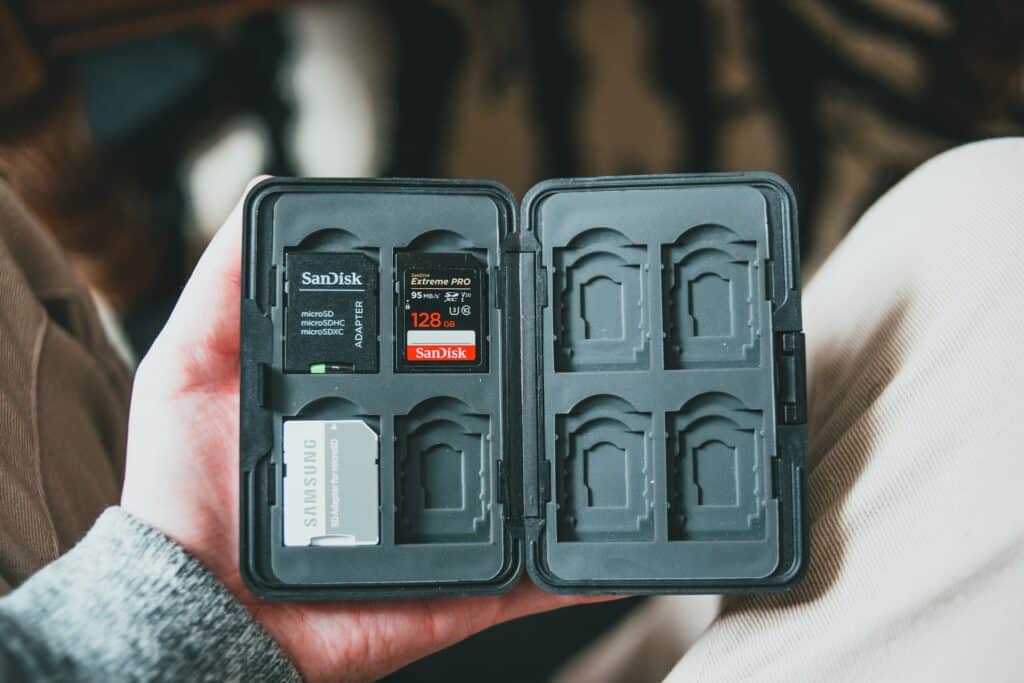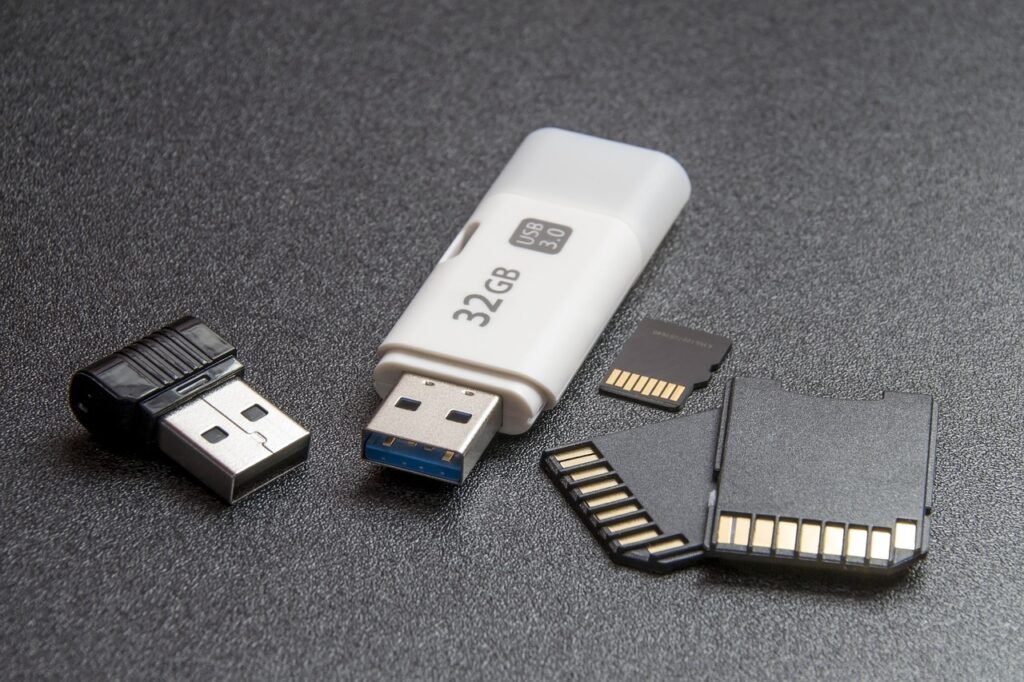The need for storage devices has grown exponentially. From professional photographers and filmmakers to everyday smartphone users, we all rely on these ingenious inventions to hold our digital data.
Two such storage formats — SD and Memory cards — are prevalent. While these terms are often used interchangeably, they are not synonymous.
This blog post will delve into “What is the difference between an SD Card and Memory Card,” helping you understand which best suits your needs.

Related: How SD Card Lock Works
Memory Card: The Umbrella Term
Memory Card’ is a generic name for data storage devices used in digital cameras, mobile phones, tablets, portable computers, and other digital devices.
These cards store data such as photos, videos, and files. They come in a variety of types, including Compact Flash (CF), Memory Stick (MS), MultiMediaCard (MMC), and, of course, Secure Digital (SD). Each type has unique characteristics, such as storage capacity, speed, and physical size.
The journey of memory cards started with CF cards, introduced by SanDisk in 1994. They were significantly larger than the other types to follow. Then came the Memory Stick, introduced by Sony, which found popularity within Sony devices. MMC cards, a predecessor to SD cards, were also used for a time but have since become less common.
The choice of memory card often depends on the device you’re using. Each device has a specific slot that fits a particular type of card. Hence, it’s crucial to know which memory card is compatible with your device before purchasing.
SD Card: A Popular Type of Memory Card
Secure Digital, or SD cards, are a specific type of memory card. They are the successors of MMC cards and have gained widespread popularity due to their compact size and large storage capacity.
SD cards are commonly used in many devices, including digital cameras, camcorders, smartphones, music players, and even gaming consoles. They come in three main types: SD, SD High Capacity (SDHC), and SD Extended Capacity (SDXC), each offering different storage capacities and speed classes.
SD cards are renowned for their reliability and affordability. They are also readily available in most electronics stores, making them convenient for many users.
Thanks to the secure digital standards, they provide excellent data protection features, such as copyright protection, which is crucial for professionals who need to secure their digital work.
Are SD cards and Memory Cards the Same?
SD cards and memory cards are terms often used interchangeably, but there are some distinctions to consider. SD cards, which stand for Secure Digital cards, are a type of memory card.
Memory card is a broader term encompassing various data storage devices, including CompactFlash (CF), Memory Stick, MicroSD, and SD cards.
Therefore, while all SD cards are memory cards, not all memory cards are SD cards. Each type of memory card has unique features and is compatible with specific devices. So, when choosing a card, it’s essential to consider your device’s specifications and requirements.
What is SD Card Best For?

SD Cards are best suited to various applications due to their larger physical size and high storage capacity. Their capability to handle increased data transfer rates enables their use in high-definition video recording devices such as DSLR cameras, camcorders, and high-speed burst photography.
Due to their size compatibility, SD Cards are also the preferred choice for larger devices like laptops and desktop computers.
Additionally, with an added layer of security through the Write Protect Switch, SD Cards offer secure data storage, making them a reliable choice for professionals dealing with sensitive or copyrighted content. In conclusion, the benefits of SD Cards are best utilized in high-demand applications where size is not a limiting factor.
What is Memory Card Best For?

Memory cards are versatile, catering to devices beyond digital cameras and smartphones. Their compact size makes them perfect for smaller gadgets like drones, action cameras, portable gaming consoles, and digital music players.
Additionally, with their robust build, memory cards like CF and Memory Stick cards are ideal for professional-grade cameras, where durability is paramount. Their ability to support high-capacity storage enables users to store substantial amounts of data, including high-definition photos and videos.
Moreover, certain memory cards like the Sony Memory Stick offer proprietary benefits such as MagicGate copyright protection technology, making them a preferred choice for protecting intellectual property.
In essence, the usage of memory cards is best suited to applications where compactness, durability, and high storage capacity are of utmost importance.
What is the Difference Between an SD Card and Memory Card
1) Size Difference
The size difference between SD cards and other types of memory cards can be considerable. SD cards are relatively compact, measuring 32.0×24.0×2.1 mm, making them a convenient choice for many portable devices.
In comparison, CF cards, another type of memory card, are significantly larger, measuring 42.8×36.4×3.3 mm. This larger size was beneficial during the early days of digital photography, when devices were larger overall.
Still, as technology has progressed and devices have become more compact, the smaller size of SD cards has proven more advantageous.
Memory Stick cards, another type of memory card, are longer but narrower than SD cards, measuring 50.0×21.5×2.8 mm. This elongated shape may fit specific devices better, but overall, the compact and versatile size of SD cards has contributed significantly to their widespread popularity.
Regardless of the type of memory card, it’s crucial to ensure that the card you choose fits the slot on your device, both in terms of physical dimensions and compatibility with your device’s software.
2) Application Difference

The application difference between SD cards and other types of memory cards primarily comes down to the device you’re using. As a specific type of memory card, SD cards are often the go-to choice for digital cameras, camcorders, and some smartphones due to their high storage capacity and compact size.
The SDXC variety of SD cards, in particular, offers up to 2TB of storage and faster data transfer speeds, making it a favored choice for professionals who handle large files such as high-resolution photos and 4K videos. SDHC cards, with a maximum capacity of 32GB, are a more affordable option for everyday users who don’t require as much space.
On the other hand, CF cards, while larger and less common today, still hold a place in some professional-grade cameras due to their robust build quality and high transfer speeds. Memory Stick cards, primarily used in Sony devices, are often preferred for their proprietary benefits, such as MagicGate copyright protection technology.
Ultimately, the choice between an SD card and another type of memory card depends on your specific needs and the compatibility of your device. It’s recommended to check your device’s specifications or user manual for the most accurate information regarding memory card compatibility.
3) Max Capacity Difference
Regarding maximum storage capacity, different types of memory cards offer various limits. SD cards have evolved, resulting in the creation of SDHC and SDXC cards. Standard SD cards can hold up to 2GB of data, while SDHC (High Capacity) cards can store up to 32 GB. The SDXC (Extended Capacity) variety pushes the boundary further, offering a jaw-dropping maximum capacity of up to 2TB.
On the other hand, other types of memory cards, such as CF cards and Memory Sticks, have their capacity limits. CF cards, widely used in professional-grade cameras, can support up to 512GB of storage. Memory Stick PRO Duo, popular in Sony devices, offers a maximum capacity of 32GB.
4) Security Technology Difference
In terms of security technology, there are notable differences between SD cards and other types of memory cards. SD cards have copyright protection features, including Content Protection for Recordable Media (CPRM) and the Secure Digital Music Initiative (SDMI) standard, safeguarding intellectual property rights.
Contrastingly, CompactFlash (CF) cards do not inherently have these protective features. However, they often include SecureDigital Music Initiative (SDMI) and SmartMedia cards that support ID copyright protection, which helps protect digital content from unauthorized copying or reproduction.
Memory Stick cards, particularly those from Sony, possess the proprietary MagicGate technology. MagicGate is a copyright protection technology that encrypts secure content, effectively preventing unauthorized copying or transfer of digital content. This feature is particularly beneficial in devices such as digital music players and game consoles.
Which SD Card or Memory Card Capacity Do You Need?

Choosing the appropriate SD or memory card capacity depends on your specific needs and the type of device you’re using.
You might need an SD card with a large capacity if you’re using a high-resolution DSLR camera or a 4K video recorder. SDXC cards supporting 64GB and 2TB would be an ideal choice. These high-capacity cards can store large numbers of high-resolution images or extended lengths of 4K video.
On the other hand, a Micro SD card with a moderate capacity would be sufficient if you’re using a smartphone or tablet for everyday purposes like taking photos, recording casual videos, listening to music, or installing apps.
A Micro SDHC card, which can store between 4GB and 32GB, or a Micro SDXC card, which can store between 64GB and 1TB, might suit these needs.
However, always remember that higher capacity does not always mean better. It’s essential to consider the maximum capacity limit of your device and whether it can utilize the total storage capacity of the SD or memory card.
Conclusion
In conclusion, while SD and Memory Cards serve the same essential purpose of data storage, they differ significantly in several aspects, such as capacity, security features, size, and compatibility with different devices.
With their high storage capacity and secure copyright protection, SD Cards are ideal for high-demand applications like DSLR cameras, camcorders, and computers.
On the other hand, Memory Cards, known for their compactness and robust build, cater to a wide range of smaller devices like drones, action cameras, and portable gaming consoles.
The choice between an SD Card and a Memory Card ultimately depends on the specific requirements of your device and your personal needs. Consider your device’s maximum capacity limit before purchasing a memory card.
Frequently Asked Questions
Does an SD card increase storage?
Yes, an SD card can significantly increase the storage capacity of your device. SD cards are an external storage source, offering additional space to store photos, videos, music, documents, and other files, especially when the device’s internal storage is insufficient.
This feature can be particularly beneficial for devices with limited built-in storage. By simply inserting an SD card into the device’s dedicated slot, you can enhance its storage capacity, allowing more data to be stored and accessed.
However, it’s crucial to ensure that your device is compatible with the SD card’s capacity to utilize its storage potential fully.
Can SD cards be used for memory?
SD cards can indeed be used for memory. Primarily, they act as an extension of the device’s internal memory, providing extra storage space for data.
This means you can store more pictures, videos, music, apps, and other files on your device. Moreover, SD cards are removable and portable, allowing you to transfer and share data between devices.
However, it’s important to remember that the device you’re using must be compatible with the SD card, as some devices have limitations on the maximum capacity they can support. Always check the device’s specifications before purchasing an SD card to ensure it can fully utilize its memory capacity.
Does an SD card add storage or memory?
SD cards add both storage and memory to a device. They are an external storage source, providing additional space for saving photos, videos, documents, etc.
This is particularly useful when the device’s internal storage is full or insufficient.
At the same time, SD cards also serve as memory extensions. They can hold apps and their data, essentially acting as an extended memory for the device.
However, be sure to check the compatibility of the SD card with your device, as some devices have limitations regarding the maximum capacity they can handle.